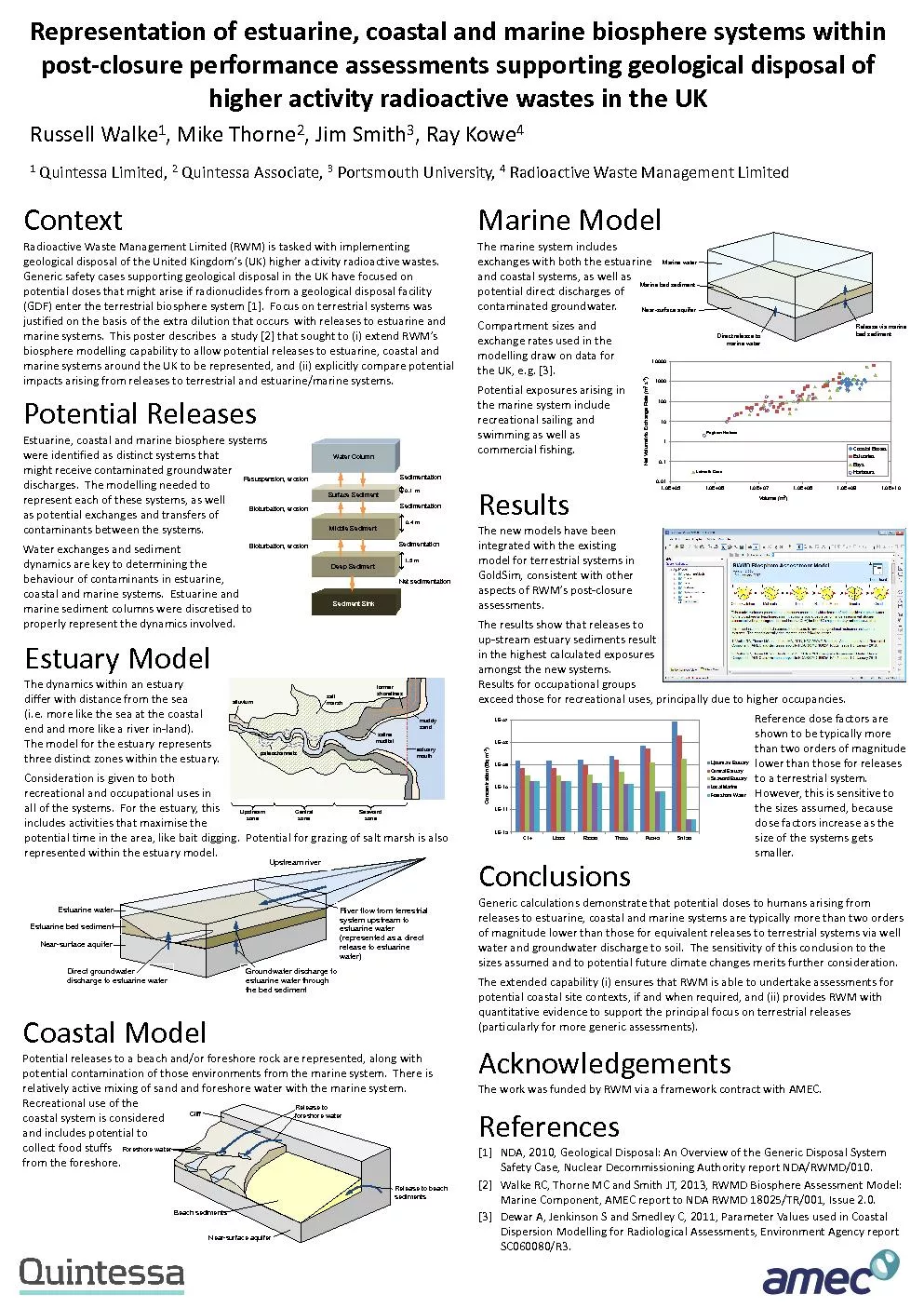

The marine system includes exchanges with both the estuarine and coastal systems as well as potential direct discharges of contaminated groundwater Compartment sizes and exchange rates used in t ID: 836230
Download Pdf The PPT/PDF document "Marine Model" is the property of its rightful owner. Permission is granted to download and print the materials on this web site for personal, non-commercial use only, and to display it on your personal computer provided you do not modify the materials and that you retain all copyright notices contained in the materials. By downloading content from our website, you accept the terms of this agreement.
1 Marine Model The marine system include
Marine Model The marine system includes exchanges with both the estuarine and coastal systems, as well as potential direct discharges of contaminated groundwater. Compartment sizes and exchange rates used in the modelling draw on data for the UK, e.g. [3]. Potential exposures arising in the marine system include recreational sailing and swimming as well as commercial fishing. Potential Releases Estuarine, coastal and marine biosphere systems were identified as distinct systems that might receive contaminated groundwater discharges. The modelling needed to represent each of these systems, as well as potential exchanges and transfers of contaminants between the systems. Water exchanges and sediment dynamics are key to determining the behaviour of contaminants in estuarine, coastal and marine systems. Estuarine and marine sediment columns were discretised to properly represent the dynamics involved. Estuary Model The dynamics within an estuary differ with distance from the sea (i.e. more like the sea at the coastal end and more like a river in - land). The model for the estuary represents three distinct zones within the estuary. Consideration is given to both recreational and occupational uses in all of the systems. For the estuary, this includes activities that maximise the potential time in the area, like bait digging. Potential for grazing of salt marsh is also represented within the estuary model. Results The new models have been integrated with the existing model for terrestrial systems in GoldSim, consistent with other aspects of RWM’s post - closure assessments. The results show that releases to up - stream estuary sediments result in the highest calculated exposures amongst the new systems. Results for occupational groups exceed those for recreational uses, principally due to higher occupancies. Reference dose factors are shown to be typically more than two orders of magnitude lower than those for releases to a terrestrial system. However, this is sensitive to the sizes assumed, because dose factors increase as the size of the systems gets smaller. Representation of estuarine, coastal and marine biosphere systems within post - closure performance assessments supporting geological disposal of higher activity radioactive wastes in the UK Russell Walke 1 , Mike Thorne 2 , Jim Smith 3 , Ray Kowe 4 1 Quintessa Limited, 2 Quintessa Associate, 3 Portsmouth University, 4 Radioactive Waste Management Limited Context Radioactive Waste Management Limited (RWM) is tasked with implementing geological disposal of the United Kingdom’s (UK) higher activity radioactive wastes. Generic safety cases supporting geological disposal in the UK have focused on potential doses that might arise if radionuclides from a geological disposal facility (GDF) enter the terrestrial biosphere system [1]. Focus on terrestrial systems was justified on the basis of the extra dilution that occurs with releases to estuarine and marine systems. This poster describes a study [2] that sought to ( i ) extend RWM’s biosphere modelling capability to allow potential releases to estuarine, coastal and marine systems around the UK to be represented, and ( ii) explicitly compare potential impacts arising from releases to terrestrial and estuarine/marine systems. Coastal Model Potential releases to a beach and/or foreshore rock are represented, along with potential contamination of those environments from the marine system. There is relatively active mixing of sand and foreshore water with the marine system. Recreational use of the coastal system is considered and includes potential to collect food stuffs from the foreshore. Conclusions Generic calculations demonstrate that potential doses to humans arising from releases to estuarine, coastal and marine systems are typically more than two orders of magnitude lower than those for equivalent releases to terrestrial systems via well water and groundwater discharge to soil. The sensitivity of this conclusion to the sizes assumed and to potential future climate changes merits further consideration. The extended capability ( i ) ensures that RWM is able to undertake assessments for potential coastal site contexts, if and when required, and (ii) provides RWM with quantitative evidence to support the principal focus on terrestrial releases (particularly for more generic assessments). Acknowledgements The work was funded by RWM via a framework contract with AMEC. References [1] NDA, 2010, Geological Disposal: An Overview of the Generic Disposal System Safety Case, Nuclear Decommissioning Authority report NDA/RWMD/010. [2] Walke RC, Thorne MC and Smith JT, 2013, RWMD Biosphere Assessment Model: Marine Component, AMEC report to NDA RWMD 18025/TR/001, Issue 2.0. [3] Dewar A, Jenkinson S and Smedley C, 2011, Parameter Values used in Coastal Dispersion Modelling for Radiological Assessments , Environment Agency report SC060080/R3.